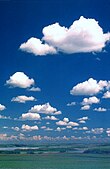Mammatus
| ||
 Zjawisko mamma na wieczornym niebie | ||
| Skrót nazwy | mam | |
|---|---|---|
| Piętro | wszystkie piętra | |
| Wygląd | wypukłości u podstawy chmury | |
mamma (mam) (łac. mamma – wymię, pierś) (znane też jako mammatus) – wypukłości znajdujące się w dolnej części chmury, wyglądem przypominające wymiona[1].
Zjawisko to występuje w chmurach:
Odmiana ta występuje zwłaszcza przy chmurach Stratocumulus i Cumulonimbus u ich podstawy lub, jak to ma najczęściej miejsce u cumulonimbusa, w dolnej części kowadła. Tę odmianę obserwuje się czasem u chmur Cirrus, prawdopodobnie wówczas, gdy pochodzą one z rozpadającego się kowadła chmury Cumulonimbus.
Przypisy
- ↑ Międzynarodowy Atlas Chmur, Państwowy Instytut Hydrologiczno-meteorologiczny, 1956
Bibliografia
- Mirosław Bogusz, Poradnik obserwacji chmur Wrocław, styczeń 2002
Media użyte na tej stronie
Mammatus Clouds
Autor: Dwindrim (dyskusja · edycje), Licencja: CC BY-SA 1.0
This sky has "nice day" written all over it. The cumulus humilis indicates very little convection in the lower atmosphere, and the fact that it is well-formed indicates light winds at low levels. There is no cloud aloft, and thus no moisture or stable conditions or both. The cumulus congestus on the horizon suggests showers may be possible three or four hours from now, at the earliest, but chances are good it will remain a pleasant day through until the evening. The azure blue is typical of Alberta's clear, dust/haze/pollution-free skies.


